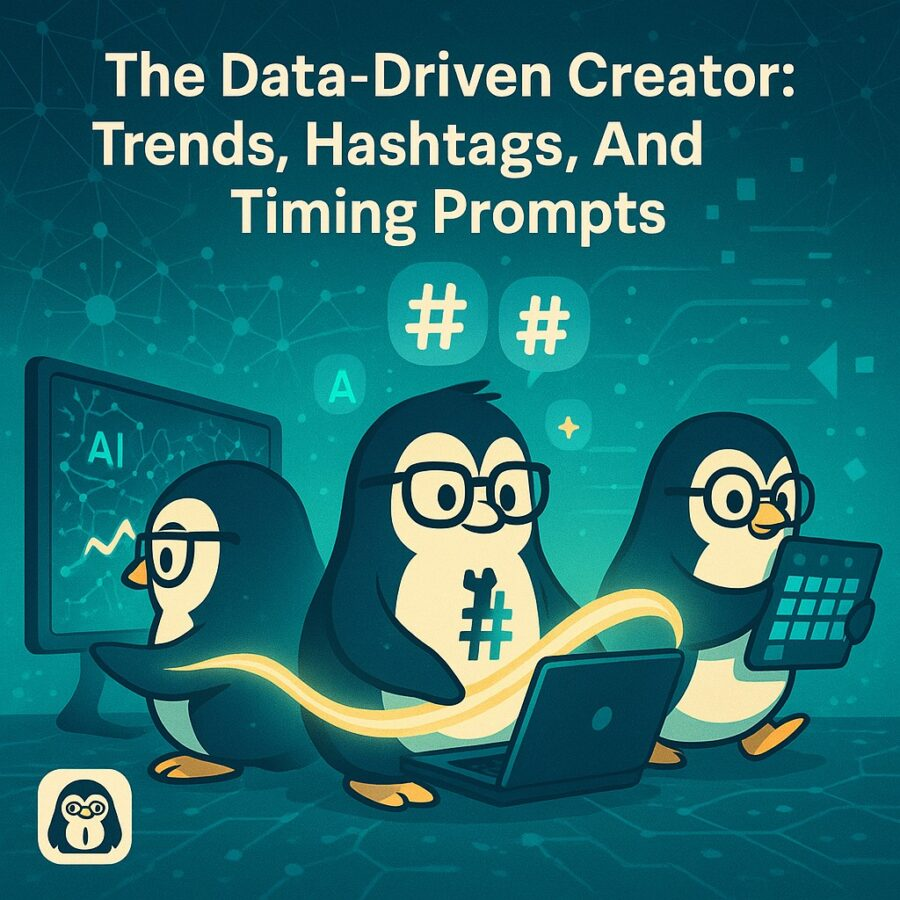Views: 1
Why the “data driven creator” mindset matters now
If you build content by gut feeling alone, you might hit occasional hits—but you will also waste time. A data driven creator uses signals from trends, hashtag patterns, and post timing to shape content that resonates and spreads. The goal is to turn guesses into experiments, and experiments into repeatable wins.
Imagine you’re in Hogwarts creating magical content. You would not throw spells blindly — you would use a map, timing, and knowledge of environment. Similarly, by tapping into trend data, hashtag intelligence, and timing prompts, you can cast your content with more precision.
This article will unpack:
- How to spot content trends early
- How to choose hashtags that amplify reach
- When to post (timing rules)
- Prompt templates you can feed into AI tools
- A strategy you can test this week
By the end, you’ll see how data driven creator prompts become part of your creative toolkit, not a gimmick.
What does being a data driven creator mean?
A data driven creator blends intuition with quantitative signals. It is about:
- Observing what people engage with
- Testing small content versions
- Iterating based on performance
- Scaling what works
It is not about slavishly following every viral topic. Instead, it’s about filtering trends through your niche, personality, and capacity.
You could liken it to a Quidditch seeker who watches the patterns of the Snitch. You don’t chase every flutter; you anticipate where it will be next. That is the core of being a data driven creator.
Affiliate Link
See our Affiliate Disclosure page for more details on what affiliate links do for our website.
Subscribe to Amazon Prime today and be prepared for the Spooky Season.
(Click the image below to Join Amazon Prime using our affiliate link.)
Trend spotting: how to read the current currents
Trends are the raw material. But not all trends are good fits. This section covers how to find, filter, and use trend data.
Use Google Trends and related tools
Start with Google Trends. You can compare topic pairs, filter by region, and spot rising terms. Yoast highlights how trend analysis helps you shift content strategy based on real signals. (Yoast)
For example, a spike in “prompt engineering” in your niche might signal content that rides that wave. But instead of creating 101-level content, you could craft a unique angle for your audience.
Also monitor YouTube Trends, TikTok Discover, Reddit rising subthreads, and niche forums.
Watch trend shifts in hashtags
Research from the H-ADAPTS methodology shows advanced systems detect hashtag shifts in real time and adapt suggestions accordingly. (arXiv) In practice, that means hashtag relevance changes. A tag that works today might flop tomorrow.
You want hashtags that are climbing, not saturated. Use tools like Hashtagify, Ritetag, TikTok hashtag analytics, and platform native suggestions. Track which tags your peers use and which get engagement.
Track content performance as feedback
Your own posts are trend detectors. Use analytics (Instagram Insights, TikTok analytics, Twitter/X analytics, LinkedIn stats) to see which content types got high reach, saves, shares, or comments.
Record the headline, hashtag set, timing, and format of those.
Then treat those as signals. If your prompt content about “AI for side hustle” in short video format got traction, make variants and test them again.
Hashtag strategy for reach and relevance
Good hashtags increase discoverability. But to use them well, you need smart selection and layering.
Tier hashtags: mix of broad, niche, and micro
- Broad tags (e.g. #AI, #Content) get volume but high competition
- Niche tags (e.g. #AIforCreators, #PromptHacks) hit a more relevant crowd
- Micro / branded tags (e.g. #AltPenguinPrompts) help you track engagement
Use 4–8 per post depending on platform. On Instagram or X, mix a broad, 2–3 niche, and one micro tag.
Monitor trending tags daily
Scan tags in your industry. Use tools or even platform explore pages. On TikTok, the trending tags change rapidly. Pick 1 trending tag per post when it fits, but don’t force it if irrelevant.
Avoid banned or shadowbanned tags
Some tags are hidden or penalized due to misuse. Always check whether a hashtag is allowed by searching it on the platform. A tag that gives zero results is suspect.
Use prompt-based hashtag prompts
Here are a few prompt templates you can feed into ChatGPT or another AI:
- “Suggest 5 niche hashtags and 3 trending hashtags for topic X for Instagram.”
- “Generate a layered tag set (broad, niche, micro) for content about Y.”
- “Detect rising hashtags in niche Z this week.”
- “Rewrite this tag list to improve reach and reduce redundancy.”
These will help you not guess the tags but let AI assist your tag curation.
Affiliate Link
See our Affiliate Disclosure page for more details on what affiliate links do for our website.

Posting timing: when your content gets seen
Even a great piece fails if posted at a dead hour. Timing matters because of audience habits, algorithm signals, and feed windows.
Basic timing principles
- Go live when your audience is awake and active
- Avoid late night, unless your audience is global and nocturnal
- Post slightly before peak hours to hit algorithm boost
Every platform has its trends. For instance, Instagram users often scroll right after lunch or early evening. For professionals, LinkedIn activity peaks around mornings and noon.
Use analytics to refine your schedule
Check your platform’s analytics: see when followers are online, and which posts got better reach by time. Use that as your initial window. Then test slight shifts ±1 hour for a few weeks.
Rotate posting slots
Use at least two posting windows per day (if you have enough content). So even if one slot is saturated, the other may bring new eyes. For example, post in morning and evening for global reach.
Prompt templates for timing
Here are timing prompts you can use:
- “Suggest 3 optimal posting hours (local time) for niche X on Instagram.”
- “Predict when audience in time zone Y is most active for content about Z.”
- “Given my analytics showing spikes at A, B, C times, propose a posting schedule for next 14 days.”
- “Compare between morning, midday, evening slots for best impressions in my niche.”
These prompts guide your decision based on real data rather than guesswork.
Prompt templates to tie trends, hashtags, and timing together
Here are full prompt templates you can drop into AI to generate content aligned with trend, tags, and schedule. Treat them as your toolkit.
- Trend-aware content prompt:
“Using the rising topics in niche X this week, write 5 content ideas with hooks, relevant hashtags, and ideal post time windows.” - Hashtag + caption generator:
“Generate a caption and tag set (6 tags) for this post topic, optimizing for reach and relevance.” - Timing + repost plan:
“Suggest a 3-post schedule (dates and hours) for this content in audience time zone, plus times to repost in future weeks.” - Trend adaptation prompt:
“Given this trend spike on topic X, write a reactive post with hook, key point, and interactive CTA (save, share) including 4 hashtags.” - Content experiment planner:
“Propose a 4-variant test for a post: vary hook, hashtag set, and posting time; outline how to measure performance and pick a winner.”
Each of these is a mini strategy. Coupled with your analytics, you can validate what works and discard what doesn’t.
Affiliate Link
See our Affiliate Disclosure page for more details on what affiliate links do for our website.
](https://altpenguin.com/wp-content/uploads/2025/08/veed-ad.webp)
Example scenario: applying the strategy
Let’s walk through a hypothetical using a niche: “AI tools for small creators.”
Step 1: Trend scan
You scan Google Trends and see “ChatGPT prompt engineering” rising. On TikTok, you see short videos titled “prompt hacks 2025” getting traction.
Step 2: Hashtags
You plug into AI: “Suggest 5 niche hashtags and 3 trending hashtags for ‘prompt engineering’ topic.” It returns: #PromptEngineering, #AIForCreators, #PromptHacks, #ChatGPTTips, #CreatorTools, #TrendingNow, #AI. You choose a mix for your post.
Step 3: Timing
Your analytics indicate your Instagram followers are most active at 12pm and 8pm. You schedule the post for 11:45am to catch early momentum, then repost at 8pm to capture second wave.
Step 4: Content prompt
You feed a prompt:
“Using rising topic ‘prompt engineering’, write a 60-word post with a hook, one viral tip, and 6 hashtags, timed for an 11:45am post.”
The AI gives a caption, with tags, hook, body. You tweak to your voice, plug in your name, then post.
Step 5: Measure and iterate
You check reach, saves, comments, and whether trending hashtag exposure gave lifts. Use those signals in future posts. Save your best prompt in a “data driven creator prompts” folder.
You repeat this cycle every week.
Common mistakes and how to avoid them
Even with a strategy, creators slip up. Here are pitfalls:
- Using tags that aren’t relevant just because they are trending
- Posting when your audience is offline
- Letting one viral post mislead you into over-repetition
- Not recording prompt formulas that worked
- Ignoring plateau signals (stalled growth)
If you hit a plateau, it is like being stuck in the Room of Requirement at Hogwarts. You must shift approach, try a new hook, change tags, or time differently. Don’t trust one pattern forever.
Building your prompts vault: a weekly routine
To become truly data driven creator, you should build your own prompt vault. Here’s a weekly routine:
- Trend scan: 10 minutes on Google Trends, TikTok, forums
- Tag scan: note 5 tags rising
- Create 1–2 content pieces with prompts tied to those
- Schedule them at 2 optimal windows
- After 24–48 hours, record performance metrics
- Archive prompt + tag + timing combination if it hits metrics
- Adjust next week based on what underperformed or overperformed
Over time, your vault becomes a set of data driven creator prompts that are personalized to your voice and niche.
Affiliate Link
See our Affiliate Disclosure page for more details on what affiliate links do for our website.
How many times to mention SEO keyphrase & readability checks
I have used data driven creator prompts already several times (in title, subheads, and text). You will want your content platform (like WordPress with Yoast) to check:
- The keyphrase appears in title, first paragraph, subheads, and near the conclusion
- Your sentences are not overly long
- You use transition words (but not too many) (neuronwriter.com)
- You avoid passive voice when possible
- You keep paragraphs short
Balance is key. You do not want to force the phrase in every sentence.
Final thoughts: grow smart, not just fast
The difference between a creator who gets lucky and one who scales is having systems. The systems here are trend scanning, hashtag layering, timing testing, and prompt iteration. That combination makes you more like a wizard casting deliberate spells than someone hoping magic strikes.
Harry Potter himself might nod at this: just as he studied spells before duels, you study data before content launches. You do not rush blindly into the Forbidden Forest of viral attempts. Instead, you plan. And over time, your intuition aligns with data signals.
With data driven creator prompts in hand, you can shift from random creative bursts to methodical creative velocity. You will generate ideas faster, test smarter, and scale what works. If you ever feel you are blinking and missing signals, remember Hogwarts: sometimes the invisibility cloak only hides what you need to reveal with better tools.
Go ahead. Try one post this week using this method. Use a trending topic, mix tags, schedule at best time, and measure. You might be surprised how much more reach, engagement, and momentum you get. And if you want help building your own prompt vault or niche version, I’d be happy to help.
Let’s dive into data, sharpen our spells, and create with precision.




